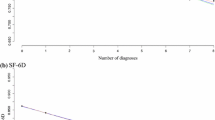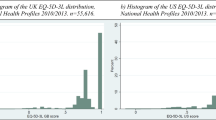Abstract
Objective: The objective of this study was to determine utility scores for various chronic conditions.
Design and setting: This study is a descriptive analysis. Health Utilities Index (HUI) scores for 20 chronic conditions were examined from the National Population Health Survey (NPHS) from 1994 to 1995.
Patients and participants: 17 626 individuals were surveyed (54.3% women). Chronic conditions included: acne (requiring medication), Alzheimer’s disease, arthritis/rheumatism, asthma, back problems excluding arthritis, chronic bronchitis or emphysema, cancer, cataracts, diabetes, epilepsy, food allergies, glaucoma, heart disease, high blood pressure, migraine headaches, other allergies, sinusitis, stroke, stomach/intestinal ulcers and urinary incontinence.
Interventions: Health Utilities Index-Mark III (HUI-Mark III) scores for patients with and without a NPHS-defined chronic condition were collected. Utility scores were examined according to age, gender and comorbidity.
Main outcome measures and results: 42.6% of individuals reported having no NPHS-defined chronic condition. The most commonly reported health conditions were allergies other than food (17.6%) and rheumatism/arthritis (16.5%). The mean HUI-Mark III scores for patients without a health state was 0.933 ± 0.079. Individuals with Alzheimer’s disease (0.580 ± 0.263), stroke (0.676 ± 0.230) and urinary incontinence (0.698 ± 0.230) had the lowest overall HUI-Mark III scores. Utility scores decreased as age and as the number of comorbid conditions increased.
Conclusions: This study provides health economists, researchers and policymakers with a reference for health utilities of various chronic conditions, different age groups, gender and comorbidities.
Similar content being viewed by others
References
Canadian Coordinating Office for Health Technology Assessment (CCOHTA). Guidelines for economic evaluation of pharmaceuticals: Canada. 2nd ed. Toronto (ON): Ministry of Health, 1997
Torrance GW. Measurement of health state utilities for economic appraisal: a review. J Health Econ 1986; 5: 1–30
Torrance GW, Furlong W, Feeny D, et al. Multi-attribute preference functions: health utilities index. Pharmacoeconomics 1995; 7(6): 503–20
Rizzo JA, Pashko S, Friedkin R, et al. Linking the health utilities index to National Medical Expenditure Survey Data. Pharmacoeconomics 1998; 13 (5 Pt 1): 531–41
Statistics Canada. National Population Health Survey: 1994-95. Ottawa (ON): Statistics Canada, 1995
Robinson R. Cost-utility analysis. BMJ 1993; 307: 859–62
Boyle M, Furlong W, Feeny D, et al. Reliability of the Health Utilites Index-Mark III used in the 1991 cycle 6 Canadian General Survey Health Questionnaire. Qual Life 1995; 4: 249–57
Fergusson BM, Keown PA. An introduction to utility measurement in health care. Infect Control Hosp Epidemiol 1995; 16 (4): 240–7
Drummond M, O’Brien B, Stoddart GL, et al. Methods for the economic evaluation of health care programs. 2nd ed. Oxford: Oxford University Press, 1997
Sackett DL, Torrance G. The utility of different health states as perceived by the general public. J Chronic Dis 1978; 31 (11): 697–704
Roberge R, Berthelot J, Wolfson M. The Health Utilities Index: measuring differences in Ontario by socioeconomic status. Health Rep 1995; 7 (2): 25–32
Fryback DG, Dasbach EJ, Klein R, et al. The Beaver Dam Health Outcomes Study: initial catalog of health-state quality factors. Med Decis Making 1993; 13: 89–102
Gold M, Granks P, Erickson P. Assessing the health of the nation: the predictive validity of a preference-based measure and self-rated health. Med Care 1996; 34 (2): 163–77
Author information
Authors and Affiliations
Corresponding author
Rights and permissions
About this article
Cite this article
Mittmann, N., Trakas, K., Risebrough, N. et al. Utility Scores for Chronic Conditions in a Community-Dwelling Population. Pharmacoeconomics 15, 369–376 (1999). https://doi.org/10.2165/00019053-199915040-00004
Published:
Issue Date:
DOI: https://doi.org/10.2165/00019053-199915040-00004




